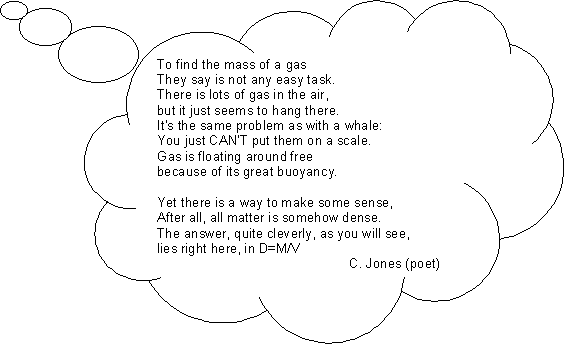
Mass o' the gas!!

In this lab activity, we are going to take advantage of gas's relatively low density and it's relatively high buoyancy. Prior this lab, I had us all share our ideas of how to find the mass of a gas. Because we want accurate results, we will follow the same procedure, share our data, and calculate the average. If we are careful we will get great results:
METHOD ONE:
To make our gas we will use Alka SeltzerÒ tablets, which produce carbon dioxide (CO2).
![]()
|
Mass of beaker and water (g) |
Mass of Tablet (g) |
Mass of beaker contents (g) |
Inferred mass of CO2 (g) |
|
|
Your trial: |
||||
|
Class Averages: |
na |
na |
Discussion notes:
Carbon dioxide has a certain density. Its density will change as temperature changes. At normal pressure and room temperature (20° C) CO2 has a density of:
If you have the density and the volume of a gas, you can find the mass of the gas. The trick is how do you find the volume of a gas? Try this!
METHOD TWO:
![]()
|
Starting volume (mL) |
_ |
Ending volume (mL) |
= |
Volume of gas (mL) |
|
|
- |
= |
||
|
- |
= |
|||
|
- |
= |
|||
|
- |
= |
|||
|
- |
= |
|||
|
- |
= |
|||
|
- |
= |
|||
|
- |
= |
|||
|
- |
= |
|||
|
AVERAGE: |
||||
Discussion notes: